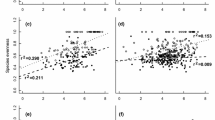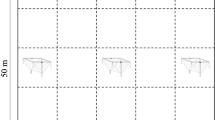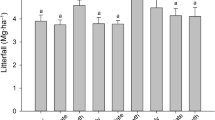Abstract
Spatial self-organisation of plants and soils is a typical feature of many systems. Different mechanisms have been proposed to explain self-organised patterns, including scale-dependent feedbacks and disturbance recovery mechanisms. In semi-arid systems, there is limited evidence for the spatial self-organisation of leaf litter despite its obvious presence within self-organised vegetation patches. Here we provide field-based evidence for the spatial self-organisation of surface litter. We measured the cover, size distribution and spatial arrangement of perennial vegetation patches and surface litter patches in four vegetation communities in a semi-arid woodland, one of which had been cleared of trees 50 years previously. The effects of tree removal were still evident 50 years after clearing, with greater perennial patch cover and greater variability in surface litter arrangement in the cleared community than the uncleared analogue. Across all communities, we detected a high correlation between perennial patch cover and litter cover. We found no evidence to support scale-dependent feedbacks occurring between litter and perennial patches, with little relationship between perennial patch size and the strength of its association with litter. The distribution of litter patch sizes was consistent with a truncated power law relationship, suggesting that disturbance–recovery mechanisms may play an important role in the spatial self-organisation of litter, particularly through large-scale processes such as wind disturbance.




Similar content being viewed by others
References
Anderson MJ, Gorley RN, Clarke KR. 2008. PERMANOVA+ for PRIMER: guide to software and statistical methods. Plymouth: PRIMER-E.
Anselin L. 1995. Local Indicators of Spatial Association—LISA. Geogr Anal 27:93–115.
Archard S. 2012. Brainwaver: basic wavelet analysis of multivariate time series with a visualisation and parametrisation using graph theory. R package version 1.6. http://CRAN.R-project.org/package=brainwaver.
Badano EI, Cavieres LA. 2006. Ecosystem engineering across ecosystems: do engineer species sharing common features have generalized or idiosyncratic effects on species diversity? J Biogeogr 33:304–13.
Badano EI, Jones CG, Cavieres LA, Wright JP. 2006. Assessing impacts of ecosystem engineers on community organization: a general approach illustrated by effects of a high–Andean cushion plant. Oikos 115:369–85.
BOM. 2012. Bureau of Meteorology. Australian Government. http://www.bom.gov.au/.
Bouma TJ, Friedrichs M, van Wesenbeeck BK, Temmerman S, Graf G, Herman PMJ. 2009. Density-dependent linkage of scale-dependent feedbacks: a flume study on the intertidal macrophyte Spartina anglica. Oikos 118:260–8.
Daryanto S, Eldridge DJ, Wang LX. 2013. Ploughing and grazing alter the spatial patterning of surface soils in a shrub-encroached woodland. Geoderma 200:67–76.
Dean WRJ, Milton SJ, Jeltsch F. 1999. Large trees, fertile islands, and birds in arid savanna. J Arid Environ 41:61–78.
Eldridge DJ, Bowker MA, Maestre FT, Roger E, Reynolds JF, Whitford WG. 2011. Impacts of shrub encroachment on ecosystem structure and functioning: towards a global synthesis. Ecol Lett 14:709–22.
Eldridge DJ, Wong VNL. 2005. Clumped and isolated trees influence soil nutrient levels in an Australian temperate box woodland. Plant Soil 270:331–42.
Facelli JM, Pickett STA. 1991. Plant litter—its dynamics and effects on plant community structure. Bot Rev 57:1–32.
Guichard F, Halpin PM, Allison GW, Lubchenco J, Menge BA. 2003. Mussel disturbance dynamics: signatures of oceanographic forcing from local interactions. Am Nat 161:889–904.
Haslem A, Kelly LT, Nimmo DG, Watson SJ, Kenny SA, Taylor RS, Avitabile SC, Callister KE, Spence-Bailey LM, Clarke MF, Bennett AF. 2011. Habitat or fuel? Implications of long-term, post-fire dynamics for the development of key resources for fauna and fire. J Appl Ecol 48:247–56.
HilleRisLambers R, Rietkerk M, van den Bosch F, Prins HHT, de Kroon H. 2001. Vegetation pattern formation in semi-arid grazing systems. Ecology 82:50–61.
Kennington JL, Helgarson RV. 1980. Algorithms for network programming. New York: Wiley.
Kefi S, Rietkerk M, Alados CL, Pueyo Y, Papanastasis VP, ElAich A, de Ruiter PC. 2007. Spatial vegetation patterns and imminent desertification in Mediterranean arid ecosystems. Nature 449:213–15.
Kefi S, Rietkerk M, Roy M, Franc A, de Ruiter PC, Pascual M. 2011. Robust scaling in ecosystems and the meltdown of patch size distributions before extinction. Ecol Lett 14:29–35.
Kessler MA, Werner BT. 2003. Self-organization of sorted patterned ground. Science 299:380–3.
Klausmeier CA. 1999. Regular and irregular patterns in semiarid vegetation. Science 284:1826–8.
Lejeune O, Tlidi M, Couteron P. 2002. Localized vegetation patches: a self–organized response to resource scarcity. Phys Rev E 66:010901.
Levin SA, Segel LA. 1985. Pattern generation in space and aspect. Siam Rev 27:45–67.
Li JR, Okin GS, Alvarez LJ, Epstein HE. 2009. Sediment deposition and soil nutrient heterogeneity in two desert grassland ecosystems, southern New Mexico. Plant Soil 319:67–84.
Ludwig JA, Tongway DJ. 1995. Spatial-organization of landscapes and its function in semiarid woodlands, Australia. Landsc Ecol 10:51–63.
Ludwig JA, Tongway DJ, Marsden SG. 1999. Stripes, strands or stipples: modelling the influence of three landscape banding patterns on resource capture and productivity in semi-arid woodlands, Australia. Catena 37:257–73.
Maestre FT. 2003. Small-scale spatial patterns of two soil lichens in semi-arid Mediterranean steppe. Lichenol 35:71–81.
Maestre FT, Cortina J. 2004. Insights into ecosystem composition and function in a sequence of degraded semiarid steppes. Restor Ecol 12:494–502.
Malamud BD, Morein G, Turcotte DL. 1998. Forest fires: an example of self-organized critical behavior. Science 281:1840–2.
Mayor AG, Bautista S, Bellot J. 2009. Factors and interactions controlling infiltration, runoff, and soil loss at the microscale in a patchy Mediterranean semiarid landscape. Earth Surf Process Landf 34:1702–11.
McElhinny C, Lowson C, Schneemann B, Pachon C. 2010. Variation in litter under individual tree crowns: implications for scattered tree ecosystems. Austral Ecol 35:87–95.
Minitab. 2010. Reference Manual, Release 16. Minitab Inc, State College Pennsylvania.
Mitzenmacher M. 2003. A brief history of generative models for power law and lognormal distributions. Internet Math 1:226–51.
Okin JS, D’Odorico P, Archer SR. 2009. Impact of feedbacks on Chihuahuan desert grasslands: transience and metastability. J Geophys Res. doi:10.1029/2008JG000833.
Pascual M, Roy M, Guichard F, Flierl G. 2002. Cluster size distributions: signatures of self organization in spatial ecologies. Philos Trans Royal Soc London B 357:657–66.
Pascual M, Guichard F. 2005. Criticality and disturbance in spatial ecological systems. Trends Ecol Evol 20:88–95.
Perry JN. 1998. Measures of spatial pattern for counts. Ecology 79:1008–17.
Perry JN, Dixon P. 2002. A new method for measuring spatial association in ecological count data. Ecoscience 9:133–41.
Perry JN, Winder L, Holland JM, Alston RD. 1999. Red–blue plots for detecting clusters in count data. Ecol Lett 2:106–13.
Pueyo S. 2011. Desertification and power laws. Landsc Ecol 26:305–9.
R Core Team. 2013. R: a language and environment for statistical computing. Vienna: R Foundation for Statistical Computing.
Rietkerk M, Brovkin V, van Bodegom PM, Claussen M, Dekker SC, Dijkstra HA, Goryachkin SV, Kabat P, van Nes EH, Neutel AM, Nicholson SE, Nobre C, Petoukhov V, Provenzale A, Scheffer M, Seneviratne SI. 2011. Local ecosystem feedbacks and critical transitions in the climate. Ecol Complex 8:223–8.
Rietkerk M, Van de Koppel J. 2008. Regular pattern formation in real ecosystems. Trends Ecol Evol 23:169–75.
Robertson GP. 2000. GS+: geostatistics for environmental science. Plainwell: Gamma Design Software.
Schlesinger WH, Raikes JA, Hartley AE, Cross AF. 1996. On the spatial pattern of soil nutrients in desert ecosystems. Ecology 77:364–74.
Shachak M, Boeken B, Groner E, Kadmon R, Lubin Y, Meron E, Ne’Eman G, Perevolotsky A, Shkedy Y, Ungar ED. 2008. Woody species as landscape modulators and their effect on biodiversity patterns. Bioscience 58:209–21.
Tongway DJ, Ludwig JA. 1990. Vegetation and soil patterning in semiarid mulga lands of eastern Australia. Aust J Ecol 15:23–34.
Tongway DJ, Valentin C, Seghieri J. 2001. Banded vegetation patterning in arid and semiarid environments: ecological processes and consequences for management. New York: Springer.
Travers SK, Eldridge DJ. 2012. Landscape modulators and resource accumulation in a post–fire eucalypt woodland. Forest Ecol Manag 285:11–19.
Wang LX, Mou PP, Huang JH, Wang J. 2007. Spatial heterogeneity of soil nitrogen in a subtropical forest in China. Plant Soil 295:137–50.
Westbrooke ME. 2012. The pastoral history, biological and cultural significance of the Scotia country, far western New South Wales. In: Proceedings of the Linnean Society of New South Wales. 134: 55–68.
Westbrooke ME, Miller JD, Kerr MKC. 1998. The vegetation of the Scotia 1: 100,000 map sheet, western New South Wales. Cunninghamia 5:665–84.
Winder L, Alexander C, Holland JM, Woolley C, Perry JN. 2001. Modelling the dynamic spatio–temporal response of predators to transient prey patches in the field. Ecol Lett 4:568–76.
Acknowledgments
We thank Fernando Maestre for his advice on LISA analyses, Angela Kenny and Alex James for their assistance with field work and Alan Kwok, Lixin Wang, Jose Facelli, Brandon Bestelmeyer and two anonymous reviewers for comments on earlier drafts. We are grateful for the financial and logistical support provided by the Australian Wildlife Conservancy and to Matt Hayward, Joe Stephens, Jennifer Cathcart, Felicity L’Hotellier and staff at Scotia Sanctuary for their continued support and encouragement.
Author information
Authors and Affiliations
Corresponding author
Additional information
Author contributions
SKT performed the research, analysed the data and primarily wrote the manuscript. DJE conceived and designed the study, contributed to data analysis and contributed to writing the manuscript.
Electronic Supplementary Material
Below is the link to the electronic supplementary material.
Rights and permissions
About this article
Cite this article
Travers, S.K., Eldridge, D.J. Evidence for the Spatial Self-organisation of Litter Patches in a Semi-arid Woodland. Ecosystems 18, 958–970 (2015). https://doi.org/10.1007/s10021-015-9876-7
Received:
Accepted:
Published:
Issue Date:
DOI: https://doi.org/10.1007/s10021-015-9876-7




